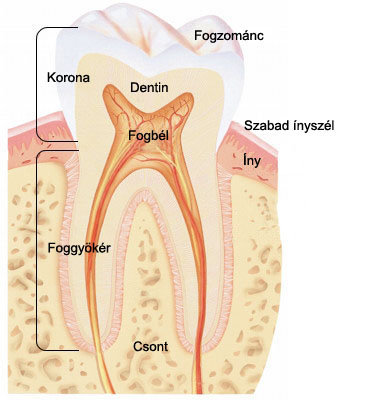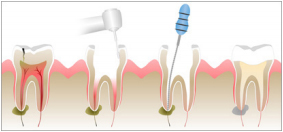Toothache can be caused by several things. It is often the case that the patient complains of toothache, while the inflammation of the tissues surrounding the tooth (gingivitis, periodontal disease pockets) is the cause of the complaints.
The tooth transmits all stimuli (cold, heat, pressure) to the sensory centre of the brain as pain, i.e. every stimulus causes pain. When our teeth give us a pain signal, don’t neglect it, prevent it!
But why can such a small part of us cause so much pain?

(image source : thehealthsite.com)
The tooth is a closed system. Its outer protective layer is enamel, an extremely strong, hard tissue, followed by dentin. Together, enamel and dentin protect and contain the “soul” of the tooth, the nerve fibre, also known as the pulp.
The nerve endings in the pulp transmit impulses to the brain, causing pain. If the protective covering (enamel, dentin) is damaged by tooth decay or any trauma to the tooth, our body reacts immediately with pain.
But what are the causes of these signals?
Toothache can be caused by tooth decay, mechanical tooth damage, tooth wear, malocclusion (wisdom tooth inflammation) and gum atrophy, nocturnal teeth grinding, overloading of teeth.
Most common is the tooth decay caused by pain. In cases where caries-causing bacteria approach the pulp, the tooth becomes sensitive to heat stimuli (cold ice cream, hot soup, etc.) and osmotic stimuli (sweet, salty foods). In such cases, it is worth consulting a dentist, as the removal of the cavity and a , in most cases the problem is solved and the process can be reversed.
In cases where the bacteria have invaded the pulp chamber and the root of the tooth – infecting it with the toxins they produce – both the intensity of the pain and the treatment change.
What are the symptoms such tooth root inflammation and how how can it be treated?
- the pain is spontaneous, severe and often unbearable,
- dull, throbbing, not subsiding even after the stimulus has stopped,
- the pain is often radiating, making it difficult to locate the tooth,
- night pain
In this case, we choose the treatment depending on the condition of the tooth. If the tooth is in good condition (suitable for future restoration), the we opt for root canal treatment .
Contrary to popular belief, root canal treatment is a painless process made possible by the use of modern techniques.

(image source: www.smileguide.com)
The root canal treatment is performedunder local anaesthesia , so the patient does not feel anything during the treatment.
Root treatment process – in brief
- anaesthetise the tooth to be treated and the surrounding area
- the first step in root canal therapy is to open up the inside of the tooth, visiting the root canals to remove inflamed or damaged gum
- determine the exact length of the root canals (usually by X-ray)
- we clean out and dilate the canals so that the antiseptic, anti-inflammatory medicine inserted later can work over as large an area as possible.
- temporary filling is placed on top
- at the next appointment, if the tooth is free of symptoms and appears free of infection on re-cleaning, a root filling is made and checked again by X-ray.
In heavily infected teeth, multiple changes of anti-inflammatory medication may be necessary to eliminate bacteria completely, which may vary the number of treatments.
If you have any questions or would like to have your teeth checked, please feel free to contact our dentists who will be happy to help you!

